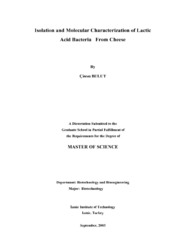Please use this identifier to cite or link to this item:
https://hdl.handle.net/11147/3114Full metadata record
| DC Field | Value | Language |
|---|---|---|
| dc.contributor.advisor | Yenidünya, Ali Fazıl | - |
| dc.contributor.author | Bulut, Çisem | - |
| dc.date.accessioned | 2014-07-22T13:50:53Z | - |
| dc.date.available | 2014-07-22T13:50:53Z | - |
| dc.date.issued | 2003 | - |
| dc.identifier.uri | http://hdl.handle.net/11147/3114 | - |
| dc.description | Thesis (Master)--Izmir Institute of Technology, Biotechnology, Izmir, 2003 | en_US |
| dc.description | Includes bibliographical references (leaves: 72-77) | en_US |
| dc.description | Text in English;Abstract: Turkish and English | en_US |
| dc.description | viii, 102 leaves | en_US |
| dc.description.abstract | Specially selected starter cultures are required for the industrial production of cheese. These starter cultures are mainly composed of lactic acid bacteria (LAB). StarterLAB have many functions in cheese production. They produce lactic acid during the fermentation process and provide formation of the curd. Futhermore, they show proteolytic activity and also they play a role in the production of aroma compounds and antimicrobial substances. In order to prevent loss of LAB biodiversity and loss of traditional cheese diversity, it is important to identify novel LAB from traditional cheese.The aim of this project was to isolate and identify natural LAB flora involved in traditional "Çömlek Peyniri" fermentation. In order to achive this goal, LAB were isolated and characterized by using phenotypic ( cell morphology, Gram staining, physiological and biochemical tests ) and genotypic methods (PCR- Restriction Fragment Length Polymorphism). Moreover, technological characterization was performed by monitoring the acid production profiles of the isolates.At the end of the study, a total of 113 coccal and 21 mesophilic lactobacilli were obtained and maintained for future use. It was found that cocci shaped isolates included 54 lactococci and 59 enterecocci. Further identification at the species level indicated that all of the lactococci isolates were L. lactis ssp. lactis. Thirty of the enterecocci were E. faecium, 8 of them were E. faecalis , 3 of them were E. avium, 2 of them were E. durans and 16 of them were other Enterococcus ssp. Lactobacilli isolates were identified as Lb. paracasei ssp. paracasei (3 isolate), Lb. casei ( 3 isolate ) and other Lactobacillus spp ( 15 isolate) . PCR-RFLP method which is based on the amplification of 16S rRNA- ITS genes and restriction digestion with HaeIII and TaqI endonucleases was found to be useful for further identification. Finally, acid production profiles of isolates indicated that 35 of the isolates could lower the pH of UHT skim milk below 5.3 for 6 h incubation at 30 °C and these isolates were therefore the best starter candidates for industrial applications. | en_US |
| dc.language.iso | en | en_US |
| dc.publisher | Izmir Institute of Technology | en_US |
| dc.rights | info:eu-repo/semantics/openAccess | en_US |
| dc.subject.lcc | QR121. B85 2003 | en |
| dc.subject.lcsh | Lactic acid bacteria | en |
| dc.subject.lcsh | Biotechnological microorganisms Isolation | en |
| dc.subject.lcsh | Cheese--Microbiology | en |
| dc.subject.lcsh | Bacterial starter cultures | en |
| dc.title | Isolation and Molecular Characterization of Lactic Acid Bacteria From Cheese | en_US |
| dc.type | Master Thesis | en_US |
| dc.institutionauthor | Bulut, Çisem | - |
| dc.department | Thesis (Master)--İzmir Institute of Technology, Bioengineering | en_US |
| dc.relation.publicationcategory | Tez | en_US |
| dc.identifier.wosquality | N/A | - |
| dc.identifier.scopusquality | N/A | - |
| item.openairetype | Master Thesis | - |
| item.cerifentitytype | Publications | - |
| item.grantfulltext | open | - |
| item.openairecristype | http://purl.org/coar/resource_type/c_18cf | - |
| item.fulltext | With Fulltext | - |
| item.languageiso639-1 | en | - |
| Appears in Collections: | Master Degree / Yüksek Lisans Tezleri | |
Files in This Item:
| File | Description | Size | Format | |
|---|---|---|---|---|
| T000269.pdf | MasterThesis | 749.27 kB | Adobe PDF |  View/Open |
CORE Recommender
Items in GCRIS Repository are protected by copyright, with all rights reserved, unless otherwise indicated.